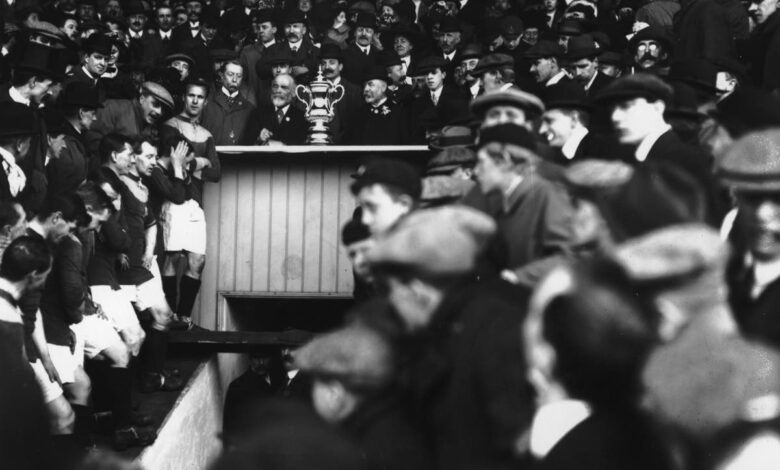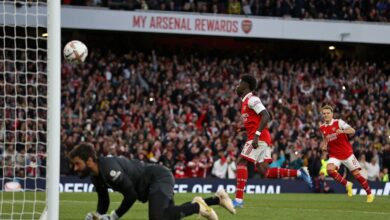‘The greatest thrill is playing at Wembley’: What the FA Cup final used to mean

There aren’t too many similarities between the football of 1953 and now, but there’s something about Saturday that means Chelsea and Liverpool players might feel the way Nat Lofthouse did ahead of that most famous of FA Cup finals. With a capacity crowd returning to Wembley for the first time since 2019, Liverpool enjoying their first in a decade and many of these Chelsea players gracing their first non-pandemic final, they might well have the same sense of wonder Lofthouse did in 1953. The Bolton Wanderers hero had played at Wembley many times, but even he was struck by the uniqueness of the stage as he lined up in the tunnel that day.
“All you can see of the stadium is a small square of light some 20 or 30 yards ahead,” Lofthouse is quoted as saying in David Tossell’s book The Great English Final. “There will be a joke and a laugh but the tension is there. Then you start the long walk towards that square of light.”
Graeme Sharp felt the same in 1984. “The closer you’re getting to the top, the noisier it’s becoming,” the Everton FA Cup hero tells The Independent. “Then you come out of the tunnel into the open air, and it’s just unbelievable.”
The immediate thought, Sharp says, is that “I’m in a game now.” Lofthouse described it as being “in another world”.
The truth is that it has been a different world for the FA Cup final for some time, one which doesn’t inspire the same awe. Rather than again lamenting that the competition has lost meaning as it reaches its 150th anniversary, though, it is for once worth reflecting on what that meaning has been for so much of the time. They are values that are all the more important to cherish amid Champions League changes, and two years when everyone has been forced apart.
The FA Cup final used to be English football’s national day, when every part of the game came together. That was because everyone gathered together, particularly in the communities from which the finalists hailed. Such congregations were a recognition of the very achievement winning the FA Cup used to be. It was a different challenge to the league championship, sure, but that was precisely why it was for a long time considered an equal feat. There was a “mystique” to it like the modern Champions League final, where every moment was imbued with decades of history. That afforded it a grandiosity that was itself only amplified by the smaller parts of the day, the traditions that added to every triumph.
This grand spirit of communion initially came from a great breakthrough, and some of the same societal forces that condition the game today: the wealthy against the poor; the establishment against the proletariat.
Twelve years after the FA Cup’s 1871 foundation, the northern working-class professionals of Blackburn Olympic finally ended the domination of the southern aristocrats playing the game as a pastime, as Old Etonians were beaten 2-1. That defeat heralded an immediate democratisation of the sport. The sudden-death nature of knockout football also offered a source of both entertainment and inspiration for so many individuals, as well as identity. Towns became bound around such feats.
By 1904, 20,000 Manchester City supporters were getting trains down to London to watch Billy Meredith win the trophy against Bolton.
“One thing that really struck me when I first studied the FA Cup was to read the reports about travelling fans going to their final,” football historian David Goldblatt says. “That’s the moment – Blackburn Olympic and then Blackburn Rovers winning the FA Cup in the mid-1880s – that marks a passing, that transition from a primarily aristocratic pursuit to a working-class game. It’s all that sense of the reach of it, a rare cross-class and increasingly national phenomenon. Those Blackburn fans, as well as the players, would never have been to London before. That’s huge. For working-class Blackburn to be part of the national narrative, in the same sphere as the Old Etonians, that must have been a really powerful and intoxicating thing in Victorian England.”
The spirit of this prevailed for most of the competition’s 140 seasons. Dennis Tueart recalls similar scenes for then Second Division Sunderland’s shock run to the 1973 final against Leeds United, in what was a very different England.
“We went from playing in front of 11,000 people in November to 54,000 in April in the cup,” Tueart says. “It had an incredible effect on the community. As an example, the British ship-builders had a base on the Wear, and donated £800 to get to the semi-final and £1,200 to get to the final. That was a lot of money then. Absenteeism was also at an all-time low, and morale at an all-time high, because the lads couldn’t wait to get into work on the Monday and talk about the team at the weekend.”
The numbers were already astounding long before then. As early as 1899, Crystal Palace saw a world-record crowd of 73,833 people for Sheffield United’s 4-1 win over Derby County, only for that to be beaten by almost 40,000 just two years later as Tottenham Hotspur became the first non-league team to win the competition. The famous 1923 “white horse final” between Bolton and West Ham United, the first at Wembley, was estimated to actually attract 300,000 supporters rather than the official 126,047.
There was one spectator that specifically stood out as he took his seat in 1901. As part of another development that defined the event as a national institution, King Edward VII accepted the role of patron of the Football Association.
“That’s a big deal,” Goldblatt argues. “King Edward isn’t showing up to watch Old Etonians. It’s working-class folk at Crystal Palace. Playing in front of the queen is no big deal these days, but in 1901 that’s huge for your average working-class player and fan. That’s a really important aspect of the FA Cup.”
Royalty would bring more lofty traditions, and a few other trappings. By 1953, the late Duke of Edinburgh was offering Blackpool’s Stanley Matthews private words of encouragement as he aimed for his first FA Cup, having told the Bolton’s burly players that their white satin shirts made them look like “pansies”. Three years later, Prince Phillip was telling Bert Trautmann to see a doctor as the City goalkeeper awkwardly went up for his medal. It turned out the German had played most of the 3-1 win over Birmingham City with a broken neck, as a former Nazi soldier became a national hero.
If the royals were among a privileged few watching this growing showpiece in person, a further crucial development was that everyone soon was able to experience it in some other form. The BBC decided to broadcast the 1927 final on the radio, allowing 15,000 Cardiff City fans who couldn’t make Wembley to listen to their team finally lift their first FA Cup by beating Arsenal 1-0. That happened to be the first game that was presaged by ‘Abide With Me’, at the request of King George V. He was asked what he wanted the bands of the Grenadiers and Irish Guards to play and chose his wife Queen Mary’s favourite hymn. From hearing the song ahead of those 1955 and 1956 finals, Trautmann later remarked on the sense of communion it fostered. “Women and children from the grimy streets of the industrial town at last are on common ground with those from the stately homes of England,” Trautmann wrote in his autobiography. “It is a wonderful thing and one for which British sports lovers, regardless of politics and creed, are to be respected.”
A key was that everyone got to listen, and by then watch, as Goldblatt explains.
“The fact that the league still didn’t allow radio broadcasts in the 1930s and 1940s, because they’re worried about ticket sales, means the FA Cup final is becoming part of the national calendar in the way league football never could.
I’ve won a Championship medal, a European medal and countless Scotland caps, but sometimes I think I’d swap the lot for an FA Cup




